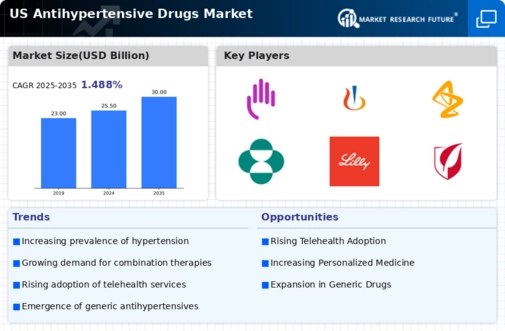Aging Population
The aging population in the US is a crucial factor driving the anti hypertensive-drugs market. As individuals age, the risk of developing hypertension increases, leading to a higher demand for effective treatment options. The US Census Bureau projects that by 2030, approximately 20 % of the population will be 65 years or older. This demographic shift is expected to result in a substantial rise in hypertension cases, thereby increasing the need for anti hypertensive medications. The anti hypertensive-drugs market is likely to adapt to this growing demand by offering tailored treatment solutions for older adults, who may have unique health considerations and comorbidities.
Rising Healthcare Expenditure
The increasing healthcare expenditure in the US is a significant driver for the anti hypertensive-drugs market. With healthcare spending projected to reach approximately $6 trillion by 2027, there is a growing focus on managing chronic conditions such as hypertension. This financial commitment allows for better access to medications and treatment options for patients. The anti hypertensive-drugs market benefits from this trend, as insurance coverage for hypertension medications expands, making them more affordable for patients. Additionally, the emphasis on preventive care and chronic disease management is likely to further stimulate demand for anti hypertensive drugs, as healthcare providers prioritize effective treatment strategies.
Advancements in Drug Development
Innovations in drug development are significantly influencing the anti hypertensive-drugs market. The introduction of novel compounds and advanced formulations has led to more effective treatment options for hypertension. Recent advancements in pharmacology have enabled the creation of drugs that target specific pathways involved in blood pressure regulation. This has resulted in improved efficacy and reduced side effects, making treatments more appealing to patients. The anti hypertensive-drugs market is witnessing a surge in research and development activities, with pharmaceutical companies investing heavily in clinical trials. As a result, the market is likely to see a steady influx of new products, catering to diverse patient needs and preferences.
Increased Awareness and Education
There is a growing awareness and education regarding hypertension and its management, which serves as a significant driver for the anti hypertensive-drugs market. Public health campaigns and initiatives aimed at educating the population about the risks associated with high blood pressure have led to increased screening and diagnosis rates. As individuals become more informed about the importance of managing their blood pressure, they are more likely to seek treatment options. The anti hypertensive-drugs market is benefiting from this trend, as healthcare providers are encouraged to prescribe medications to patients who may have previously been unaware of their condition. This heightened awareness is likely to contribute to sustained market growth.
Growing Prevalence of Hypertension
The increasing prevalence of hypertension in the US is a primary driver for the anti hypertensive-drugs market. According to the CDC, nearly 47 % of adults in the US have hypertension, which necessitates effective management strategies. This rising incidence is attributed to factors such as aging populations, sedentary lifestyles, and unhealthy dietary habits. As more individuals are diagnosed with hypertension, the demand for anti hypertensive medications is expected to rise correspondingly. The anti hypertensive-drugs market is thus positioned to expand, as healthcare providers seek to prescribe effective treatments to manage blood pressure levels. Furthermore, the growing awareness of hypertension's health risks is likely to encourage patients to seek medical advice, further propelling the market's growth.

















Leave a Comment